I am using z80 navigation control that's built-in and here is the link for demonstration: Z80 Navigation Menu
If anyone see the control, it has an object to create menus like parent menus and under it, child menus. Something like the following:
public List<NavBarItem> sampleDynamicNav; //List of navbar objects
public DemoItems()
{
//Create object instance here and assign the parent as well child menus here
sampleDynamicNav = new List<NavBarItem> {
new NavBarItem {ID = 1, Text = "UserInfo", Icon = new ItemIcon {Default = SampleProject.Properties.Resources.nav_new_home, Hover = SampleProject.Properties.Resources.nav_new_home, Selected = SampleProject.Properties.Resources.nav_new_home}, ToolTip = "tooltip Main Menu", Height = 40,
Icon = new ItemIcon {Default = SampleProject.Properties.Resources.nav_new_home, Hover = SampleProject.Properties.Resources.nav_new_home, Selected = SampleProject.Properties.Resources.nav_new_home }, ToolTip = "tooltip Desktop"},
Childs = new List<NavBarItem> {
new NavBarItem {ID = 41, Text = "Add/Edit Users", Height = 30 },
new NavBarItem {ID = 42, ParentID = 1, Text = "Inactive User", Height = 30}
};
}
This is pretty simple if we assign the menus statically. But I stuck with it, when trying to add them dynamically I mean creating the menu from database as follows:
public DemoItems()
{
foreach (var parent in GetParent("USER-0001"))
{
foreach (var child in GetChild(parent.MenuNo))
{
sampleDynamicNav = new List<NavBarItem> {
new NavBarItem {
ID = parent.MenuNo, Text = parent.MenuName, Icon = new ItemIcon {Default = SampleProject.Properties.Resources.nav_new_home, Hover = SampleProject.Properties.Resources.nav_new_home, Selected = SampleProject.Properties.Resources.nav_new_home}, ToolTip = "tooltip Main Menu", Height = 40,
Childs = new List<NavBarItem> {
new NavBarItem {ID = child.MenuNo, ParentID = parent.MenuNo, Text = child.MenuName, Height = 30 },
}
}
};
}
}
}
With the above code, it's supposed to get the parent menus at least in the navigation bar. For now, leaving the child menus aside, it shows one parent menu in the navigation bar as follows:
But it's supposed to be like the below as there are two parent menus and iterated the list (GetParents() returns a list of object) with foreach loop:
I don't know if I've to do anything else for it and wondering if I can loop through the child properties of the navigation bar, something as follows:
foreach (var child in GetChild(parent.MenuNo))
{
Childs = new List<NavBarItem> {
new NavBarItem {ID = child.MenuNo, ParentID = parent.MenuNo, Text = child.MenuName, Height = 30 },
}
N.B: When try to iterate the child properties with loop, it throws error right now. The second inner loop works and takes out the child menus as well but say, the parent menu has two sub-menus, it returns 1 at the time. I debugged the list and it returns the two parent menu as usual but doesn't show up in the navigation bar.
GetParents Method:
/**Get Menu Details - Starts**/
public IEnumerable<UserViewModel> GetParent(string empNo)
{
List<UserViewModel> lstUser = new List<UserViewModel>();
string query = "SELECT DISTINCT M.PARENT, M.MENUNO, M.MENUNAME FROM (SELECT DISTINCT M.MENUNO, M.MENUNAME, M.PARENT " +
"FROM USER_DETAILS U INNER JOIN USER_GROUP_DETAILS UG ON UG.EMPNO = U.EMPNO " +
"INNER JOIN ASSIGN_MENU_DETAILS AM ON AM.GROUPNO = UG.GROUPNO INNER JOIN MENU_DETAILS M " +
"ON M.MENUNO = AM.MENUNO WHERE U.EMPNO = '" + empNo + "' " +
"UNION ALL " +
"SELECT DISTINCT M.MENUNO, M.MENUNAME, " +
"M.PARENT FROM MENU_DETAILS M " +
"INNER JOIN MENU_DETAILS C " +
"ON C.PARENT = M.MENUNO) m WHERE M.PARENT = '0' ORDER BY M.PARENT";
DataTable dt = SelectData(query);
if (dt != null && dt.Rows.Count > 0)
{
foreach (DataRow dr in dt.Rows)
{
UserViewModel bo = new UserViewModel();
bo.Parent = Convert.ToInt32(dr["PARENT"].ToString());
bo.MenuNo = Convert.ToInt32(dr["MENUNO"].ToString());
bo.MenuName = dr["MENUNAME"].ToString();
lstUser.Add(bo);
}
}
return lstUser;
}
/**Get Menu Details - Ends**/

